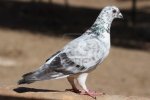My last post, variety is the spice of life, explained some of the wonders of pigeon plumage. In order to investigate the mechanisms behind the variety of beautiful colours we see today, it is important to see if there are any trends throughout the UK. My recent move to Cornwall found me noticing that there are far more pied pigeons there than 200 miles west in the city of Bath.
To get a detailed picture of just how varied pigeons are in different locations, I need YOUR help.
I’d like as many people as possible to count the pigeons in your local flock, and note down the number of each different colour type that you see. It would be great if the time, date and nearest town, city or village could be noted too. Below you will see pictures of some of the most common colour morphs you are likely to see.
As an example, your results may look a little like this:
Date: 12.07.12
Time: 15:30 –
Location: Bath
Total flock size: 50
Number of blue bar: 30
Number of chequers: 10
Number of pied: 5
Number of red: 5
If you spot any pigeons that don’t quite fit the varieties seen below, they can be simply recorded as ‘other’.
Don’t worry if your numbers aren’t perfect, especially as pigeons strut around so quickly it can be tricky to know where one bird ends and the next begins.
You can send your results by email to pigeons@gmx.co.uk or by filling in the form at the bottom of this page.
- This is blue bar pigeon
- This is a chequer pigeon
- This is a pied pigeon
- This is a red pigeon
- This is a red bar pigeon
- This is a spread – black pigeon
- This is a white pigeon
Thank you very much for your help, I hope you enjoy pigeon spotting!

















